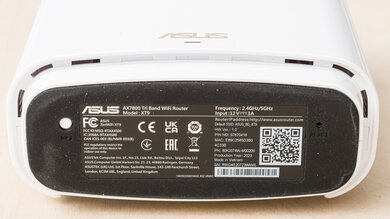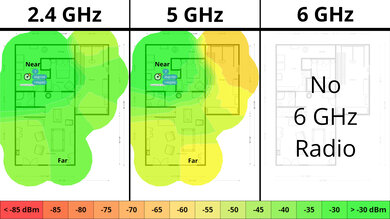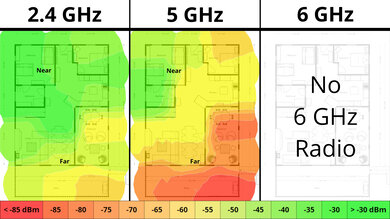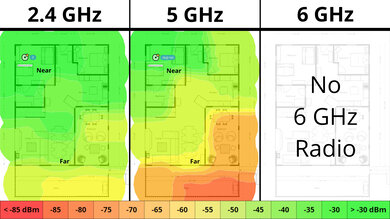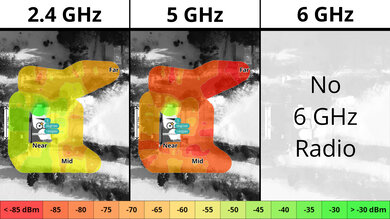The ASUS ZenWiFi XT9 is a tri-band Wi-Fi 6 router with a 2.4GHz band and two 5GHz bands. It's designed for use in a mesh system and is available in a one-pack or two-pack. It uses ASUS's AiMesh technology, so it's also compatible with any other AiMesh-enabled ASUS access point. It supports 160MHz channels on its primary 5GHz band for faster potential speeds. We bought a white two-pack and tested it in dual mesh mode.
Our Verdict
The ASUS XT9 is a great router for use in an apartment, condo, or single-story home. It has good coverage across a single floor and provides suitable speeds for downloading large files quickly and high-bandwidth 4k video streaming. It also has a sleek, compact design that easily fits into your living space. It has a USB 3.0 port and a WAN port rated for 2.5Gbps speeds.
-
Sleek and compact design available in black or white.
-
Impressive top speeds.
-
2.5Gbps WAN port.
-
Wi-Fi 6 won't take full advantage of new Wi-Fi 6E or 7 devices.
The ASUS ZenWiFi XT9 is a great router if you live in a multi-level home with a backyard. It has excellent coverage throughout a multi-story home and provides speeds fast enough for 4k video streaming and high-speed downloads. Since it's a mesh router, you can easily add another unit for better coverage. It also has a sleek, compact design that easily fits into your living space. It has a USB 3.0 port and a WAN port rated for 2.5Gbps speeds.
-
Sleek and compact design available in black or white.
-
Impressive top speeds.
-
Great range.
-
Can add additional mesh access points to further improve range.
-
2.5Gbps WAN port.
-
Wi-Fi 6 won't take full advantage of new Wi-Fi 6E or 7 devices.
The ASUS ZenWiFi XT9 AX7800 delivers impressive speeds suitable for a gigabit internet connection. It supports DFS (Dynamic Frequency Selection), so it can use less congested DFS-only channels, which helps give you better speeds in noisy wireless environments.
-
Impressive top speeds.
-
Wi-Fi 6 won't take full advantage of new Wi-Fi 6E or 7 devices.
The ASUS XT9 has great range. It's a mesh router, so you can add supplementary access points to improve your range and help maintain consistent speeds over long distances.
-
Great range.
-
Can add additional mesh access points to further improve range.
-
Wi-Fi 6 won't take full advantage of new Wi-Fi 6E or 7 devices.
Changelog
- Updated May 01, 2025: We've converted this review to Test Bench 0.8.1. This includes a new test result for our Test Configuration box.
-
Updated Nov 15, 2024:
We've added a link to the newly-reviewed ASUS ZenWiFi ET9 in the Wireless Specifications section.
- Updated Jul 22, 2024: Review published.
Check Price
Differences Between Sizes And Variants
The ASUS ZenWiFi XT9 is available in a one-pack or a two-pack and comes in black or white. We bought and tested a white two-pack. Here's a photo of our unit's label.
Compared To Other Routers
The ASUS ZenWifi XT9 is a tri-band mesh Wi-Fi 6 router with a 2.4GHz band and two 5GHz bands. It supports the 160MHz channel bandwidth on one of its 5GHz bands for faster top speeds. It notably supports configurable backhaul, so you can choose whether the main router and satellite connect to each other using a dedicated 5GHz band or an Ethernet cable. You can also leave the backhaul in automatic mode and let the router decide.
Despite this router being Wi-Fi 6 and not supporting the faster 6GHz band, it delivers similar top speeds to Wi-Fi 6E mesh routers in its price category, namely the eero Pro 6E and the TP-Link Deco XE5300.
If you're looking for more options, check out our recommendations for the best Wi-Fi routers, the best mesh Wi-Fi systems, and the best Wi-Fi 6 routers.
The ASUS ZenWiFi XT9 performs better than the ASUS ROG Rapture GT6. It's faster when you're up close and has better range, despite both being Wi-Fi 6 mesh systems with a 2.4GHz band and two 5GHz bands. The XT9 has a sleek exterior design, while the GT6 has aggressive gamer styling that may not be for everyone.
The ASUS ZenWiFi XT9 and the ASUS ZenWiFi ET9 are mesh routers from the same lineup. The ET9 is Wi-Fi 6E while the XT9 is Wi-Fi 6. They deliver similar speeds and range, but the ET9's 6GHz band should perform better in noisy wireless environments.
Test Results
This router's USB port supports USB 3.2 Gen 1 data transfer speed of up to 5Gbps.
We tested this router in dual mesh mode. While there's a slight speed penalty when initially connecting to the satellite unit, this is expected, and it helps deliver faster speeds over longer distances. For more information about the mesh penalty, check out our R&D article here.
We tested this router in dual mesh mode. While there's a slight speed penalty when initially connecting to the satellite unit, this is expected, and it helps deliver faster speeds over longer distances. For more information about the mesh penalty, check out our R&D article here.
Check out the ASUS ZenWiFi ET9 if you're looking for a similar router that supports Wi-Fi 6E.
Comments
ASUS ZenWiFi XT9: Main Discussion
Let us know why you want us to review the product here, or encourage others to vote for this product.
- 21010
Do you know what the subout voltsge is? 1v, 2,v etc?
Update: Converted to Test Bench 1.2. Updated the results for audio format support via ARC/eARC, HDMI In, and Optical. Added Video Passthrough to TV results as well.





